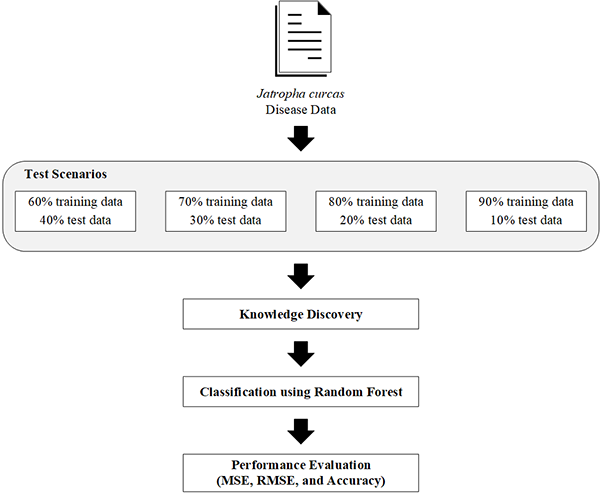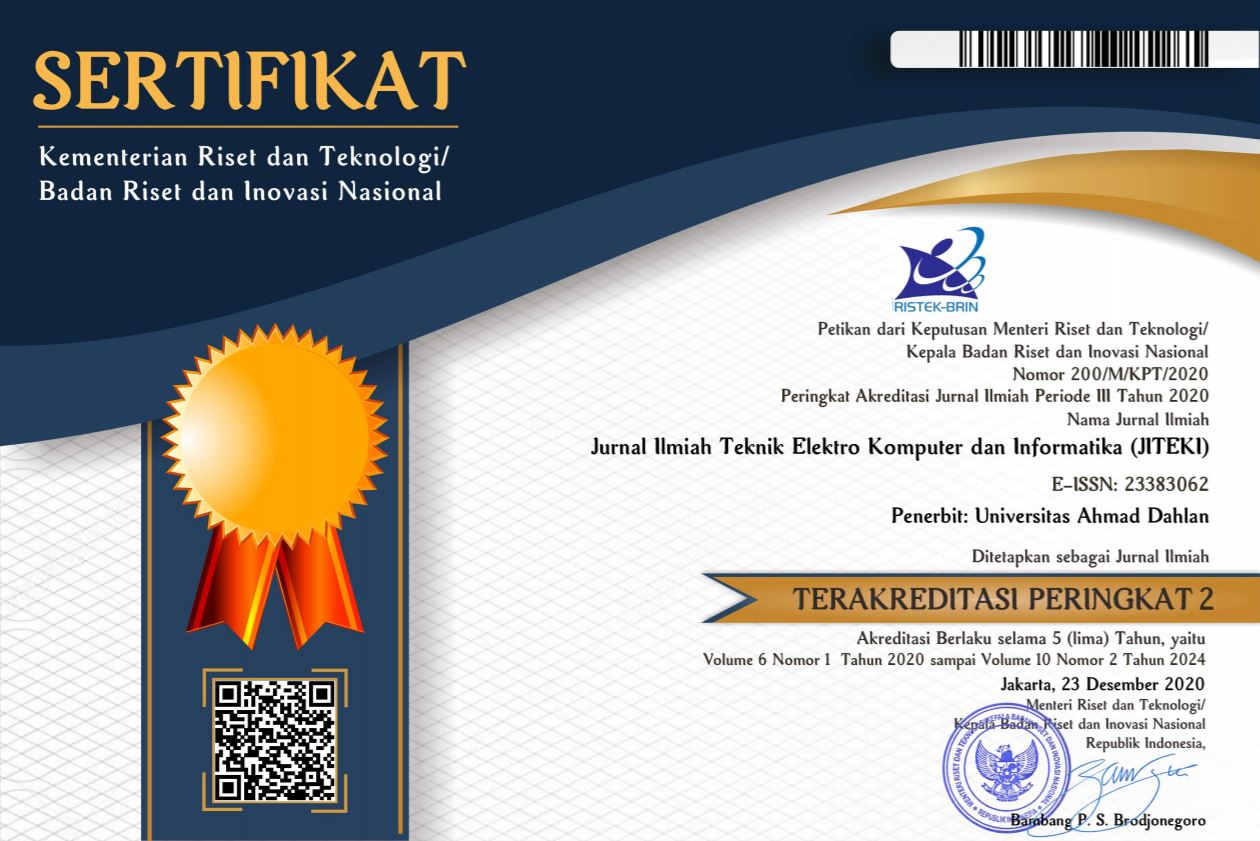
Jatropha Curcas Disease Identification using Random Forest
Abstract
Keywords
Full Text:
PDFReferences
W. F. Abobatta, “Jatropa curcas: an overview,†J. Adv. Agric., vol. 10, pp. 1650–1656, 2019. https://doi.org/10.24297/jaa.v10i0.8145
A. J. King, W. He, J. A. Cuevas, M. Freudenberger, D. Ramiaramanana, and I. A. Graham, “Potential of Jatropha curcas as a source of renewable oil and animal feed,†J. Exp. Bot., vol. 60, no. 10, pp. 2897–2905, 2009. https://doi.org/10.1093/jxb/erp025
H. A. Abdelgadir and J. Van Staden, “Ethnobotany, ethnopharmacology and toxicity of Jatropha curcas L. (Euphorbiaceae): A review,†South African J. Bot., vol. 88, pp. 204–218, 2013. https://doi.org/10.1016/j.sajb.2013.07.021
T. Yulianti and N. Hidayah, Jatropha Curcas Disease. Malang: Balai Penelitian Tanaman Pemanis dan Serat, 2015.
T. H. Saragih, D. M. N. Fajri, A. Hamdianah, W. F. Mahmudy, and Y. P. Anggodo, “Jatropha Curcas Disease Identification Using Fuzzy Neural Network,†in International Conference on Sustainable Information Engineering and Technology (SIET), Batu, Indonesia, 25-25 November, 2017. https://doi.org/10.1109/SIET.2017.8304153
D. M. N. Fajri, T. H. Saragih, A. Hamdianah, W. F. Mahmudy, and Y. P. Anggodo, “Optimized Fuzzy Neural Network for Jatropha Curcas Plant Disease Identification,†in International Conference on Sustainable Information Engineering and Technology (SIET), Batu, Indonesia, 25-25 November, 2017. https://doi.org/10.1109/SIET.2017.8304152
T. H. Saragih, D. M. N. Fajri, W. F. Mahmudy, A. L. Abadi, and Y. P. Anggodo, “Jatropha Curcas Disease Identification with Extreme Learning Machine,†Indones. J. Electr. Eng. Comput. Sci., vol. 12, no. 2, pp. 883–888, 2018. https://doi.org/10.11591/ijeecs.v12.i2.pp883-888
T. H. Saragih, W. F. Mahmudy, A. L. Abadi, and Y. P. Anggodo, “Application of extreme learning machine and modified simulated annealing for jatropha curcas disease identification,†Int. J. Adv. Soft Comput. its Appl., vol. 10, no. 2, pp. 108–119, 2018.
C. J. Lin, S. Y. Jeng, H. Y. Lin, and C. Y. Yu, “Design and Verification of an Interval Type-2 Fuzzy Neural Network Based on Improved Particle Swarm Optimization,†Appl. Sci., vol. 10, no. 9, pp. 3041, 2020. https://doi.org/10.3390/app10093041
M. Abdar, E. Nasarian, X. Zhou, G. Bargshady, V. N. Wijayaningrum, and S. Hussain, “Performance improvement of decision trees for diagnosis of coronary artery disease using multi filtering approach,†in 2019 IEEE 4th International Conference on Computer and Communication Systems (ICCCS), 2019, pp. 26–30. https://doi.org/10.1109/CCOMS.2019.8821633
N. Farnaaz and M. A. Jabbar, “Random Forest Modeling for Network Intrusion Detection System,†Procedia Comput. Sci., vol. 89, pp. 213–217, 2016. https://doi.org/10.1016/j.procs.2016.06.047
A. Primajaya and B. N. Sari, “Random Forest Algorithm for Prediction of Precipitation,†Indones. J. Artif. Intell. Data Min., vol. 1, no. 1, pp. 27–31, 2018. https://doi.org/10.24014/ijaidm.v1i1.4903
B. Thomas and C. J., “Random forest application on cognitive level classification of E-learning content,†Int. J. Electr. Comput. Eng., vol. 10, no. 4, pp. 4372, Aug. 2020. https://doi.org/10.11591/ijece.v10i4.pp4372-4380
Z. Rustam and G. S. Saragih, “Prediction schizophrenia using random forest,†TELKOMNIKA (Telecommunication, Comput. Electron. Control., vol. 18, no. 3, pp. 1433–1438, 2020. https://doi.org/10.12928/telkomnika.v18i3.14837
A. Clim, R. Zota, R. Constantinescu, and I. Ilie-Nemedi, “Health services in smart cities: Choosing the big data mining based decision support,†Int. J. Healthc. Manag., vol. 13, no. 1, pp. 79–87, 2020. https://doi.org/10.1080/20479700.2019.1650478
K. Anitha and K. S. Varaprasad, “Jatropha Pests and Diseases: An Overview,†in Jatropha, Challenges for a New Energy Crop, 2012, pp. 175–218. https://doi.org/10.1007/978-1-4614-4806-8_10
X. Zhou, P. Lu, Z. Zheng, D. Tolliver, and A. Keramati, “Accident Prediction Accuracy Assessment for Highway-Rail Grade Crossings Using Random Forest Algorithm Compared with Decision Tree,†Reliab. Eng. Syst. Saf., vol. 200, pp. 106931, 2020. https://doi.org/10.1016/j.ress.2020.106931
L. M. R. Rere, M. I. Fanany, and A. M. Arymurthy, “Simulated Annealing Algorithm for Deep Learning,†Procedia Comput. Sci., vol. 72, pp. 137–144, 2015. https://doi.org/10.1016/j.procs.2015.12.114
G. A. F. Alfarisy, A. N. Sihananto, T. N. Fatyanosa, M. S. Burhan, and W. F. Mahmudy, “Hybrid Genetic Algorithm and Simulated Annealing for Function Optimization,†J. Inf. Technol. Comput. Sci., vol. 1, no. 2, pp. 82–97, 2017. https://doi.org/10.25126/jitecs.20161215
T. Sousa, T. Soares, H. Morais, R. Castro, and Z. Vale, “Simulated Annealing to Handle Energy and Ancillary Services Joint Management Considering Electric Vehicles,†Electr. Power Syst. Res., vol. 136, pp. 383–397, 2016. https://doi.org/10.1016/j.epsr.2016.03.031
E. Purnamasari, D. P. Rini, and Sukemi, “The Combination of Naive Bayes and Particle Swarm Optimization Methods of Student’s Graduation Prediction,†J. Ilm. Tek. Elektro Komput. dan Inform., vol. 5, no. 2, pp. 112–119, 2019. https://doi.org/10.26555/jiteki.v5i2.15272
W. Lesmawati, A. Rahmi, and W. F. Mahmudy, “Optimization of Frozen Food Distribution Using Genetic Algorithm,†J. Environ. Eng. Sustain. Technol., vol. 03, no. 01, pp. 51–58, 2016. https://doi.org/10.21776/ub.jeest.2016.003.01.7
Q. Kotimah, W. F. Mahmudy, and V. N. Wijayaningrum, “Optimization of Fuzzy Tsukamoto Membership Function using Genetic Algorithm to Determine the River Water,†Int. J. Electr. Comput. Eng., vol. 7, no. 5, pp. 2838–2846, 2017. https://doi.org/10.11591/ijece.v7i5.pp2838-2846
I. Wahyuni and W. F. Mahmudy, “Rainfall Prediction in Tengger, Indonesia Using Hybrid Tsukamoto FIS and Genetic Algorithm Method,†J. ICT Res. Appl., vol. 11, no. 1, pp. 38–55, Apr. 2017. https://doi.org/10.5614/itbj.ict.res.appl.2017.11.1.3
A. A. Candel, Arno, Viraj Parmar, Erin LeDell, “Deep learning with H2O,†H2O. ai Inc, October, 2016.
I. Cholissodin and S. Sutrisno, “Prediction of rainfall using improved deep learning with particle swarm optimization,†TELKOMNIKA (Telecommunication Comput. Electron. Control., vol. 18, no. 5, pp. 2498, Oct. 2020. https://doi.org/10.12928/telkomnika.v18i5.14665
DOI: http://dx.doi.org/10.26555/jiteki.v7i1.20141
Refbacks
- There are currently no refbacks.
Copyright (c) 2021 Triando Hamonangan Saragih, Vivi Nur Wijayaningrum, Muhammad Haekal

This work is licensed under a Creative Commons Attribution-ShareAlike 4.0 International License.
| About the Journal | Journal Policies | Author | Information |
Organized by Electrical Engineering Department - Universitas Ahmad Dahlan
Published by Universitas Ahmad Dahlan
Website: http://journal.uad.ac.id/index.php/jiteki
Email 1: jiteki@ee.uad.ac.id



